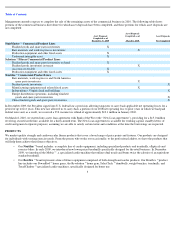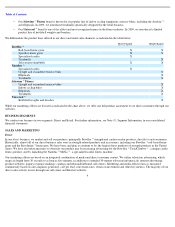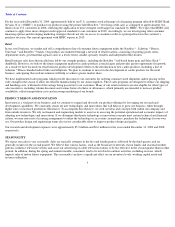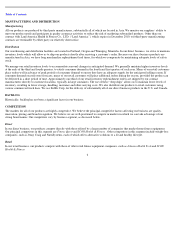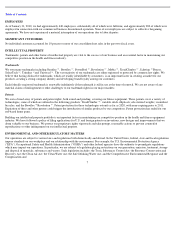Nautilus 2009 Annual Report Download - page 17
Download and view the complete annual report
Please find page 17 of the 2009 Nautilus annual report below. You can navigate through the pages in the report by either clicking on the pages listed below, or by using the keyword search tool below to find specific information within the annual report.
Table of Contents
performance of services by third parties, including those involved in shipping product to and from our distribution facilities. Our distribution
facilities are located in Oregon in the United States, and Manitoba in Canada.
Operations at our distribution facilities could be interrupted by disasters such as earthquakes or fires. We maintain business interruption
insurance, but it may not adequately protect us from the adverse effect that could be caused by significant disruptions in our distribution
network.
Our or others failure to maintain information and communication systems could result in interruptions to our business.
Our business is increasingly reliant on information and communication technology, and a substantial portion of our revenues are generated with
the support of information and communication systems. The success of our direct business is heavily dependent on our ability to respond to
customer sales inquiries and process sales transactions using our call center communication systems, internet websites and similar data
monitoring and communication systems provided and supported by third-parties. If such systems were to fail, or experience significant or
lengthy interruptions in availability or service, our revenues could be materially affected. We also rely on information systems in all stages of
our production cycle, from design to distribution, and we use such systems as a method of communication between employees, as well as our
customers. In addition, we use information systems to maintain our accounting records, assist in collection and customer service efforts, and to
forecast operating results and cash flows. System failures or service interruptions may occur as the result of a number of factors, including:
computer viruses; hacking or other unlawful activities by third parties; disasters; equipment, hardware or software failures; cable outages,
extended power failures, or our inability or failure to properly protect, repair or maintain our communication and information systems. To
mitigate the risk of business interruption, we have in place a disaster recovery program that targets our most critical operational systems. If our
disaster recovery system is ineffective (in whole or in part), or efforts conducted by us or third-parties to prevent or respond to system
interruptions in a timely manner are ineffective, our ability to conduct operations would be significantly affected. Any of the aforementioned
factors could have a material adverse affect on our operating results, financial condition and cash flows.
Currency exchange rate fluctuations could result in higher costs and reduced margins.
We have significant sales outside of the United States. As a result, we conduct transactions in various currencies which increase our exposure to
fluctuations in foreign currency exchange rates relative to the U.S. dollar. Our international revenues and expenses generally are derived from
sales and operations in non-
U.S. currencies, and these revenues and expenses could be affected by currency fluctuations. Currency exchange rate
fluctuations could also result in higher costs for our products, or could disrupt the business of independent manufacturers that produce our
products, by making their purchases of raw materials more expensive and more difficult to finance. Therefore, our future financial results could
be significantly affected by the value of the U.S. dollar in relation to the non-U.S. currencies in which we, our customers or our suppliers
conduct business.
Our business is affected by seasonality which results in fluctuations in our operating results.
We experience moderate fluctuations in aggregate sales volume during the year. Sales are typically strongest in the first and fourth quarters,
followed by the third quarter, and are generally weakest in the second quarter. However, the mix of product sales may vary considerably from
time to time as a result of changes in seasonal and geographic demand for particular types of fitness equipment. In addition, our customers may
cancel orders, change delivery schedules or change the mix of products ordered with minimal notice. As a result, we may not be able to
accurately predict our quarterly sales. Accordingly, our results of operations are likely to fluctuate significantly from period to period.
13


